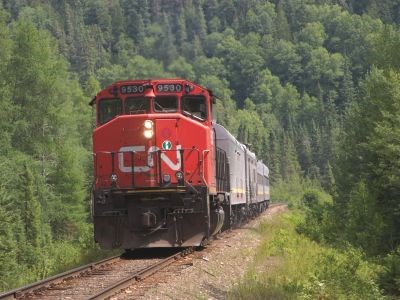It’s back to the drawing board for stakeholders hoping to preserve the Algoma Central Railway (ACR) passenger line that runs between Sault Ste. Marie and Hearst.
A request for proposals issued in August garnered three potential operators, but after their proposals were reviewed and credentials assessed, CN Rail, which owns the line, determined none was suitable for the task, said Tom Dodds, chief executive officer of the Sault Ste. Marie Economic Development Corp.
It was the second request for proposals (RFP) issued to find an operator.
Michigan-based Railmark Holdings, which was selected by CN after the first RFP was issued in September, 2014, was ultimately dismissed when it couldn’t provide proof of sufficient working capital and had difficulty meeting its obligations to CN.
CN then cancelled the passenger service last July, impacting the busy tourism season for lodge and cottage owners along the route. CN has, however, agreed to maintain the Agawa Canyon Tour Train, which runs daily excursions to view the canyon’s array of autumn colours every fall.
After an annual federal subsidy of $2.2 million was revoked in 2014, it looked like the ACR line would fold indefinitely. But lobbying by a group of stakeholders that included the City of Sault Ste. Marie, cottagers, lodge owners, First Nations, and transportation advocates was successful in getting a reprieve.
Last March, the federal government promised $5 million over three years — if the working group could secure an owner and operator that satisfied the criteria set out by CN and Transport Canada.
Following this most recent RFP, the first two proponents were rebuffed after they didn’t meet CN’s criteria, Dodds noted, while a third proponent expressed interest, but wanted to operate the train only.
“Our sense of those people are they’re really looking for somebody that’s in the region, in the community, that they can partner with,” Dodds said. “They’re interested in perhaps operating, but they’re not interested in owning that train.”
But CN has made it clear it’s not interested in the passenger service at all, Dodds noted.
Two similar types of operations exist in other regions of Canada, but both have Aboriginal ownership: Tshiuetin Rail Transportation operates out of Quebec, while Keewatin Railway Company is based out of Manitoba.
It’s a business model the working group hasn’t ruled out, and on March 7, the Coalition for Algoma Passenger Trains (CAPT) indicated it was working on a “very exciting proposal” under the initiative of Jason Gauthier, chief of the Missanabie Cree First Nation.
In a news release, group member Linda Savory Gordon said “very positive progress is being made to resume the passenger train service on the ACR line.”
“We feel very optimistic about the reinstatement of the passenger train sometime this spring,” the release said.
“The disruption of passenger train service has been very difficult for property owners and businesses, and a failure to resume passenger train services would be devastating,” the release said. “The Algoma passenger train is important to the region's economy and employment both because of its past socio-economic impacts, but also because of underdeveloped and neglected potentials both for First Nations and the broader economy and employment.”
CAPT promised an announcement after all parties had been consulted.
Dodds said after two years of leading the initiative, the EDC would be happy to offer its experience and knowledge to another organization to take it on. The EDC retains good professional relationships with both CN and Transport Canada, and it’s open to transferring that “goodwill” to another organization that has the capacity to lead the initiative, he added.
But whoever the eventual proponent is will have their own challenges.
“It’s really important that whoever owns it has the financial and business capacity to take on that activity,” Dodds said. “It’s not an insignificant thing to do, and certainly there’s a lot of hurdles to go through.”
The $5-million subsidy promised by Transport Canada was available as long as the train started operating by April 1, 2015, but that didn’t happen.
Dodds said the working group would be content to receive $2.2 million in the first year, which the group proposes reducing by 20 per cent each succeeding year.
But, as time runs out on that funding program — it ends March 31, 2018 — so does the availability of the money.
“In between now and then they would do a program review to see if they want to continue it, and so that may mean more money for the program and more opportunities for this, or status quo — which is a reasonable thing to expect — or they may change the program criteria completely,” Dodds said.
At this point, Dodds said it’s unlikely the group will issue a third RFP, as most qualified proponents will have already expressed their interest.
But the group won’t be scrambling to make any major decisions.
“After going at this twice, we’ve dampened down our expectations, and we certainly know there’s one thing that is not valuable: to rush toward some deadline and make compromises along the way,” Dodds said. “It’s not helpful to anybody.”




